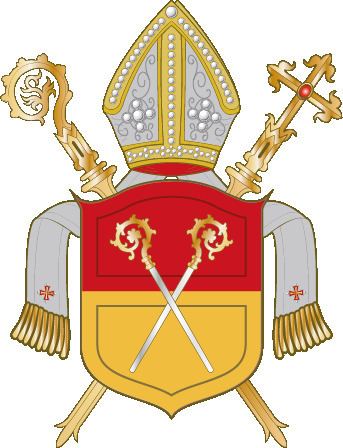 | ||
Pre-Reformation Catholic (prince-)bishopric
The bishops of the Roman Catholic diocese of Schwerin (German: Bistum Schwerin), a suffragan of the Metropolitan Archdiocese of Bremen, were simultaneously secular (political) rulers of princely rank (prince-bishop) in the Prince-Bishopric of Schwerin (German: Hochstift Schwerin; established 1180 and secularised in 1648), an imperially immediate state of the Holy Roman Empire. Schwerin was the seat of the chapter, Schwerin Cathedral and residence of the bishops until 1239. In 1180 a prince-episcopal residence was established in Bützow, which became the main residence in 1239.
Contents
- Pre Reformation Catholic prince bishopric
- Titulature of the Schwerin Bishops
- Catholic Administrators and Prince bishops 14741532
- Lutheran Regional Bishops of Mecklenburg since 1921
- New Catholic hierarchy in Schwerin from the 20th century
- References
Titulature of the Schwerin Bishops
Not all incumbents of the Schwerin See were imperially invested princely power as Prince-Bishops and not all were papally confirmed as bishops. In 1180 part of the Schwerin diocesan territory were disentangled from the Duchy of Saxony and became an own territory of imperial immediacy called Prince-Bishopric of Schwerin, a vassal of the Holy Roman Empire. The prince-bishopric was an elective monarchy, with the monarch being the respective bishop usually elected by the Cathedral chapter, and confirmed by the Holy See, or exceptionally only appointed by the Holy See. Papally confirmed bishops were then invested by the emperor with the princely regalia, thus the title prince-bishop. However, sometimes the respective incumbent of the see never gained a papal confirmation, but was still invested the princely regalia. Also the opposite occurred with a papally confirmed bishop, never invested as prince. A number of incumbents, elected by the chapter, neither achieved papal confirmation nor imperial investiture, but as a matter of fact nevertheless de facto held the princely power. From 1532 to 1648 all incumbents were Lutherans.
The respective incumbents of the see bore the following titles:
Catholic Administrators and Prince-bishops (1474–1532)
Due to the Reformation, the Catholic diocese was suppressed in 1555, without formal successor.
Lutheran Regional Bishops of Mecklenburg since 1921
When the grand dukes of Mecklenburg-Schwerin and Mecklenburg-Strelitz abdicated the Lutheran state churches became independent and adapted their new Church Orders, providing for a function called Landesbischof (state bishop). In 1934 the regional churches merged into the Evangelical Lutheran State Church of Mecklenburg.
New Catholic hierarchy in Schwerin from the 20th century
After a century and a half of abandonment, the Catholics were taken care of merely as missionary territory, part of the vast Apostolic Vicariate of the Northern Missions of Northern Germany, with the first post-Reformatory parish having been established in 1709 (St. Anna, Schwerin).
Since 1930 the Catholic parishes in the former diocese of Schwerin – and all of Mecklenburg – were part of the Roman Catholic Diocese of Osnabrück.
After Mecklenburg had become part of the Soviet occupation zone, whereas Osnabrück was in the British occupation zone (i.e. in the other half of partitioned Germany, and of the political world during the Cold War), the Bishop of Osnabrück appointed an episcopal commissary. Since 1959 the Osnabrück diocese posted an auxiliary bishop in Schwerin, responsible for Mecklenburg's Catholic parishes :
On 1973.07.23, the jurisdiction was restored as pre-diocesan 'permanent' Apostolic Administration of Schwerin, its territory being formally split off from the Diocese of Osnabruck. It has two episcopal incumbents :
On 1994.10.24 this was suppressed, its territory being reassigned to establish the Metropolitan Roman Catholic Archdiocese of Hamburg - the Catholic parishes of Mecklenburg became part of the new Roman Catholic Archdiocese of Hamburg.
